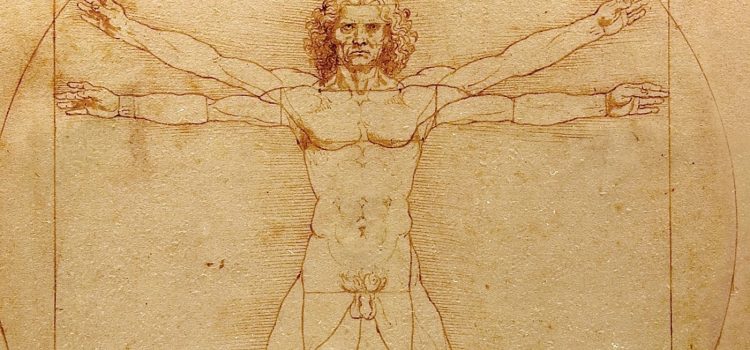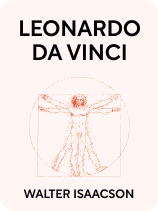

This article is an excerpt from the Shortform book guide to "Leonardo da Vinci" by Walter Isaacson. Shortform has the world's best summaries and analyses of books you should be reading.
Like this article? Sign up for a free trial here.
What does “Vitruvian Man” by Leonardo da Vinci represent? How did Leonardo use science to create art?
Leonardo da Vinci was more than just an artist—he was an architect, engineer, and scientist. For “Vitruvian Man,” Leonardo da Vinci uses science and art to capture the human body’s relationship with the cosmos.
Find out how Leonardo’s “Vitruvian Man” painting was influenced by his studies.
“Vitruvian Man”
According to Walter Isaacson in his biography of the artist, Leonardo’s “Vitruvian Man” was the result of his explorations of mathematics and philosophy and his collaboration with architects Francesco de Giorgio and Giacomo Andrea. (Shortform note: The drawing is at the Gallerie dell’Accademia in Venezia and you can see a digitized version here.)
In 1490, Leonardo and Francesco traveled together to Pavia to consult on the design of a church. During the trip, they studied a copy of a classical treatise on architecture written by Marcus Vitruvius Pollio in the first century BCE. On their return, both of them plus Giacomo became engrossed in drawing a Vitruvian man, sharing their sketches and conversations on its deeper meaning. (Shortform note: An architect discovered Giacomo’s drawing in 1986 after being lost to time after his death during the French invasion of Milan.)
Isaacson explains that Leonardo’s “Vitruvian Man” was a metaphor for the relationship between man and the cosmos. Vitruvius argued that the design for a temple should follow the proportions of a “well-shaped” man. He gave specific measurements for that well-shaped man and explained how to draw him inside a circle and a square to use as a foundation for the temple’s design. (Shortform note: The Vitruvian Man is related to the macrocosm-microcosm analogy, with the circle representing the sky and the square representing the earth.)
Vitruvius’s metaphor became popular during the Renaissance because it resonated with humanist ideals. Isaacson explains that the metaphor celebrated the place of individuals in the universe as worthy of straddling the immediacy of the earth and the timelessness of the cosmos. (Shortform note: The precise measurements also indicated that it was possible to know how humans fit in the world and the broader universe.)
Of all the drawings he and his friends made, Isaacson argues that Leonardo’s “Vitruvian Man” became the definitive one thanks to his scientific and artistic commitment. 1) While the other two produced sketches, he planned the drawing over several sketches and produced a confident final illustration. 2) He drew the details of the man’s body, face, and hair with delicate traces, making his subject a metaphor for the human and the divine. 3) He followed Vitruvius’s instructions for the placement of the man inside the circle and the square precisely, but he made adjustments to the measurements of the man. Isaacson explains that those adjustments came from his studies of anatomy and his willingness to challenge received knowledge. (Shortform note: Another change that elevated Leonardo’s drawing was placing the legs and arms in two different positions, thus creating an equilateral triangle with the legs.)
Mathematics
To understand more about how Leonardo da Vinci created the “Vitruvian Man,” you need to understand how he came to be so knowledgeable of science. Leonardo nurtured a passion for mathematics, especially geometry, throughout his life. Isaacson argues that, to Leonardo, painting was both an art and science because artists need a deep understanding of mathematics to convey their imagination through their art. (Shortform note: Researchers argue that Leonardo’s ability to create three-dimensional images is related to his affinity for solid geometry and stereometry (the measurement of solid bodies).)
The Abacus School
During his first stay in Florence, Leonardo’s father paid for his education at an abacus school. Isaacson argues that Leonardo’s takeaway from this education was using analogies and patterns. For example, he took what he knew about water eddies and hypothesized that the aortic valve used a similar process. (Shortform note: Some argue that Leonardo’s ease with making analogies was the basis of his genius. He found common patterns between phenomena to understand each individual phenomenon. For example, once he threw a stone inside a well at the same time a church bell rang. He saw the rings rippling out around the stone and imagined that sound must also travel in waves, just like water.)
Luca Pacioli’s Mentorship
From 1494 to 1499, while he lived in Milan, Leonardo and mathematician Luca Pacioli were both on Duke Ludovico’s payroll. During this time, Luca taught Leonardo geometry and algebra. Isaacson reports that Leonardo’s notebooks contain passages of Luca’s word-for-word explanations of difficult topics so that he could review them over and over.
Leonardo and Pacioli also collaborated on a book: De Divina Proportione. Luca wrote the book to explore the importance of proportion in architecture, mathematics, anatomy, and art. Leonardo was fascinated by the topic and produced 60 illustrations for the book. Always at the cutting edge, Leonardo innovated by making the illustrations see-through instead of colored so they could be easily understood. He also applied his artistic skills of light and shading to make the objects appear three-dimensional and realistic.
Anatomy
During his first stay in Milan, Leonardo collaborated with anatomy scholars at the University of Pavia who taught him to perform dissections. According to Isaacson, his studies of anatomy allowed him to explore two central questions:
1) How does man fit into the universe?
2) How do emotions transform into gestures and movements?
Isaacson identifies several scientific breakthroughs Leonardo made through dissections and observations of living people and animals:
- He was the first to draw the two halves of the skull together, to correctly draw the frontal sinus, and to give a description of the full set of human teeth.
- He was the first to study the anatomy of the human smile, including each participating nerve (He studied the smile at the time he was painting the Mona Lisa).
- He illustrated every human body part and limb.
- He explained the process that leads to arteriosclerosis.
- He was one of the first to discover that the heart was the center of the circulatory system, rather than the liver, as was then thought. He determined that the heart was a muscle with four ventricles with specific functions, and he explained how the aortic valve worked.
- Using his knowledge of sculpture, he mapped the internal cavities of the brain by injecting molding material into a skull, and he sculpted a model of a bull’s heart to test how blood ran through it.
(Shortform note: Although Leonardo’s contributions to anatomy are better known than those of his contemporaries, the Renaissance was a time of intense collaboration between artists and physicians. Artists needed physicians’ access to human bodies so they could depict them better, and physicians needed artists’ skills to capture what they discovered. This led to fruitful collaborations between both areas of human knowledge, a hallmark of the Renaissance.)

———End of Preview———
Like what you just read? Read the rest of the world's best book summary and analysis of Walter Isaacson's "Leonardo da Vinci" at Shortform.
Here's what you'll find in our full Leonardo da Vinci summary:
- A detailed look into the life, accomplishments, and struggles of Leonardo da Vinci
- Lessons from his life and work that you can apply to your own life
- What set Leonardo apart from other artists at the time






